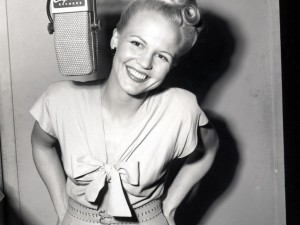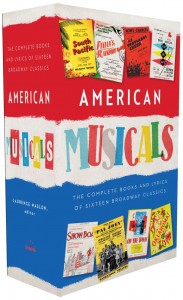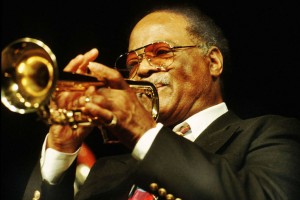 “A writer who is afraid to overreach himself is as useless as a general who is afraid to be wrong.”
“A writer who is afraid to overreach himself is as useless as a general who is afraid to be wrong.”
Raymond Chandler, “The Simple Art of Murder”
Terry Teachout on the arts in New York City
My Commentary essay for March, which has been posted a few days early, is about Peggy Lee. Here’s an excerpt.
* * *
Few things in the world of popular art are more dismaying than the spectacle of a beloved performer who goes on too long. The singer Peggy Lee was such a performer, and her decline was all the more pitiable for being so protracted. She made her last noteworthy recordings in 1975, when she was just 55 years old, and her one remaining venture of any consequence, an autobiographical Broadway show called Peg, was a shambles that closed in 1983 after only five performances. By then she had long since become a drug-dazed caricature of her younger self, and when she finally stopped singing 12 agonizing years later, her remaining fans heaved a collective sigh of relief.
 Lee lost her footing at the same moment other middle-aged pop singers such as Frank Sinatra and Tony Bennett were successfully reinventing themselves as nostalgia acts, turning their backs on a now-alien contemporary music scene and interpreting the songs of their youth with undiminished artistic integrity. Her personal problems kept her from doing as they did, and Capitol, the label for which she had made most of her best albums, let them go out of print in the ’70s. As a result, a generation of music lovers grew up knowing only the obese, grotesquely costumed woman parodied as “Miss Piggy” on The Muppet Show. Small wonder that she spent her later years begging friends to “please don’t let people forget me.”
Lee lost her footing at the same moment other middle-aged pop singers such as Frank Sinatra and Tony Bennett were successfully reinventing themselves as nostalgia acts, turning their backs on a now-alien contemporary music scene and interpreting the songs of their youth with undiminished artistic integrity. Her personal problems kept her from doing as they did, and Capitol, the label for which she had made most of her best albums, let them go out of print in the ’70s. As a result, a generation of music lovers grew up knowing only the obese, grotesquely costumed woman parodied as “Miss Piggy” on The Muppet Show. Small wonder that she spent her later years begging friends to “please don’t let people forget me.”
None of the baby boomers who watched Lee serve up limply pandering cover versions of pop-rock songs on TV in the late ’60s and early ’70s could have known that she was once an artist of the highest caliber, a peer of Sinatra who in certain ways surpassed him. A balladeer of hushed sensitivity, she was also at home in the hard-swinging world of jazz, and though her coolly glamorous, carefully sculpted public persona had much to do with her success, no one in or out of the music business ever doubted her profound musicality or perfect taste.
Why, then, did she lose her way? James Gavin has done much to answer that question in Is That All There Is?: The Strange Life of Peggy Lee, a mostly sympathetic but nonetheless very frank biography whose subtitle is indicative of its tone and approach. Gavin’s book is more concerned with Lee’s private life and public image than her music, and the tale that he tells is a sad one, the story of an unhappy woman whose neurotic insecurities grew so extreme that they eventually made it impossible for her to fully exploit her unique talents….
* * *
Read the whole thing here.
Peggy Lee and Frank Sinatra sing a duet version of “Nice Work if You Can Get It” on The Frank Sinatra Show in 1957:
It’s no place for the flippant–Arlington has a way of making the overheard remarks of ironically inclined visitors sound shameful–but it has much to offer the aesthete, even the soul-deadened kind to whom patriotism is no more than gold-braided bigotry. The simple marble headstones that mark most of the graves are at once ruthlessly functional and timelessly handsome, both individually and en masse, just as the changing of the guard at the Tomb of the Unknowns is all but balletic in its poised, precise clarity. Next to such pure classicism, the bronze plaque that honors the astronauts who died in the Challenger explosion seems almost sentimental, as much a symbol of its times as the marble tablets are of theirs….
Read the whole thing here.
 Apropos of my rave Wall Street Journal review of Hamilton, I have an essay about American Musicals, the Library of America’s new two-volume anthology of musical-comedy libretti, in the latest issue of the Weekly Standard:
Apropos of my rave Wall Street Journal review of Hamilton, I have an essay about American Musicals, the Library of America’s new two-volume anthology of musical-comedy libretti, in the latest issue of the Weekly Standard:
What is America’s greatest contribution to the arts? Time was when many, perhaps most, people would have pointed to the Broadway musical as the likeliest candidate for admission to the pantheon. Theatergoers around the world have long rejoiced in the delights of the genre, including some whom one might well have thought too snobbish to admit its excellence. (Evelyn Waugh, who had next to no use for anything made in America, saw the London production of Cole Porter’s Kiss Me, Kate a half-dozen times, pronouncing it, according to one biographer, “ingenious and admirable.”) But big-budget musical comedy has been in increasingly steep decline since the 1970s, and 10 long years have gone by since The 25th Annual Putnam County Spelling Bee, the last homegrown musical to be wholeheartedly embraced by audiences and critics alike, made it to Broadway.
Since then, we’ve seen a parade of what I call “commodity musicals,” the slavishly literal throwaway stage versions of hit movies that now dominate Broadway, as well as a number of highly imaginative small-scale musicals that, to date, have failed to draw large-scale crowds. But the old-fashioned school of Oklahoma! family musical appears to be all but gone for good, killed off by the disintegration of the common culture that made it possible in the first place. Now that Broadway-minded songwriters no longer have a universal musical language on which to draw, it isn’t possible to write a show with genuine broad-gauge audience appeal. It says everything about the desperate state of the American musical that the last theatrical song to become an enduringly popular hit, Stephen Sondheim’s “Send in the Clowns,” was written in 1973.
That’s what makes the publication of American Musicals so timely. These two volumes contain the unabridged scripts of 16 “classic” shows written between 1927 and 1969, the period now usually regarded as the “golden age” of the Broadway musical. The table of contents is itself a capsule history of the genre at its peak: Show Boat (1927), As Thousands Cheer (1933), Pal Joey (1940), Oklahoma! (1943), On the Town (1944), Finian’s Rainbow (1947), Kiss Me, Kate (1948), South Pacific (1949), Guys and Dolls (1950), The Pajama Game (1954), My Fair Lady (1956), Gypsy (1959), A Funny Thing Happened on the Way to the Forum (1962), Fiddler on the Roof (1964), Cabaret (1966), and 1776 (1969). Unlike their successors, these shows have retained their popularity. Twelve have returned to Broadway in the past decade, and two are playing there as I write. If there is a core musical-comedy repertory, this is it….
Read the whole thing here.
 Clark Terry, the great jazz trumpeter and flugelhornist, has died at the age of ninety-four after a long and cruelly debilitating illness.
Clark Terry, the great jazz trumpeter and flugelhornist, has died at the age of ninety-four after a long and cruelly debilitating illness.
Terry was the last important soloist to join Duke Ellington’s band, and his admiring recollections of his old boss, which he set down at length in his highly readable 2001 memoir and which figure prominently in my own Ellington biography, were pungent, vivid, and completely believable. “Duke,” he wrote, “was endowed with a supernatural magic that opened doors and carried him along highways and hallways, through cracks and crevices. He could cuss you out and rarely use a cuss word. He’d chastise you from the piano by playing a discord and everybody knew what was going on.”
Like Ellington, Terry himself was charming and much loved. He, too, had a strong personality, though he never sought or wanted to rival the flamboyant eccentricities of his senior colleagues in the Ellington band. This is what I wrote about him in Duke:
Not long after the Great James Robbery, Ellington hired another stalwart individualist, this one poached from Count Basie’s trumpet section. Born in St. Louis in 1920, Clark Terry was, unlike most of Ellington’s older players, conversant with the new musical language of bebop. As personally disciplined as he was musically inventive, he was a superlative addition to the roster, though Ellington did not always use him to optimum effect, in part because Terry was reluctant to co-compose with him. Understanding as he did the financial implications of splitting his publishing rights with bandleaders or selling tunes to them outright, he had no wish to cut Ellington in on his royalties. Even so, Terry admired the man and his music unreservedly and remained on board until 1959, and throughout that time his witty solos and secure ensemble work were highlights of the band’s performances and recordings….
Once Terry struck out on his own, he quickly established himself as one of the most distinctive trumpeters of his generation. He played under many flags, most notably (in my opinion) in a hard-swinging quintet whose front line he shared with my old friend Bob Brookmeyer. He also distinguished himself as a genial and encouraging jazz educator, and it was in the latter capacity that I met him when he came to play with my college jazz band in 1978. This youthful encounter was one of the reasons why I became a professional jazz musician.
Terry recorded prolifically, both as a leader and a sideman, and all of his records are worth hearing, these two in particular.
One by one our idols fall away, leaving us alone at last with the hopes and dreams that they unknowingly inspired. Farewell, Mr. Terry. I’m glad I met you once upon a time.
* * *
Peter Keepnews’ New York Times obituary is here.
The Clark Terry Quintet with Bob Brookmeyer (as the group was billed) is featured on a 1965 episode of the British TV series Jazz 625:
| M | T | W | T | F | S | S |
|---|---|---|---|---|---|---|
| 1 | 2 | 3 | 4 | |||
| 5 | 6 | 7 | 8 | 9 | 10 | 11 |
| 12 | 13 | 14 | 15 | 16 | 17 | 18 |
| 19 | 20 | 21 | 22 | 23 | 24 | 25 |
| 26 | 27 | 28 | 29 | 30 | 31 | |
An ArtsJournal Blog